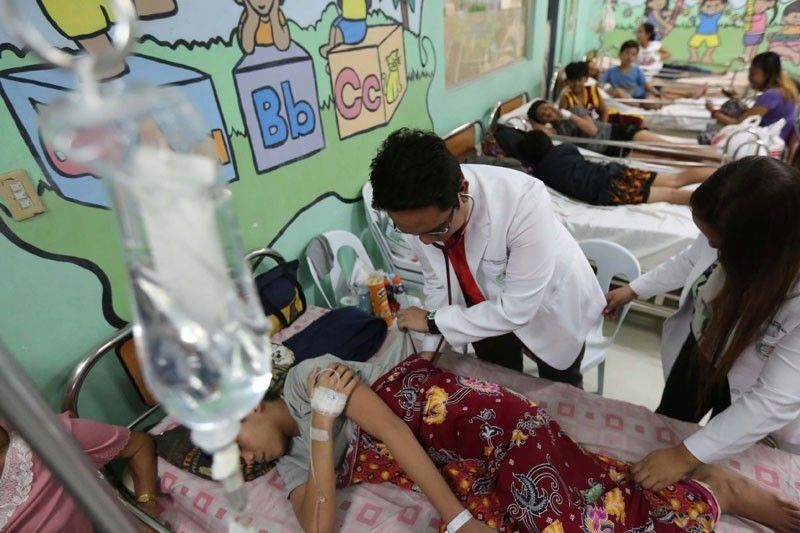National dengue epidemic

In line with National Dengue Awareness Month, the Department of Education once again informs the public about strategies on how to protect learners and the community from dengue fever, citing that dengue transmission is higher during the rainy season.
The National Dengue Awareness Month has been declared through .Proclamation No. 1204, s. 1998.
DepEd, meanwhile, lists down the strategies on how to prevent dengue fever in a Facebook post.
The Department of the Interior and Local Government calls on local government units, especially barangays, to implement measures to counter the spread of dengue in communities.
DILG Secretary Benhur Abalos Jr. says LGUs can activate the Aksyon Barangay Kontra Dengue, an inter-agency effort, to counter dengue by conducting clean-up drives.
The Bangsamoro health ministry flexes its resources to stop the continuing rise of infectious mosquito-borne dengue cases in the autonomous region.
Physician Zul Qarneyn Abas, officer-in-charge of the Ministry of Health-Bangsamoro Autonomous Region in Muslim Mindanao, tells reporters Thursday that BARMM had a total of 1,525 dengue cases, with 22 fatalities, in most recent months.
“We are doing our best to address the situation with the help of local government units in BARMM,” he says. — The STAR/John Unson
Dengue fever cases in Baguio City have risen by 61 percent against last year with 474 cases—four of whom have died—from January 1 to September 9.
This against 294 cases during the same period in 2018.
Dr. Donnabel Tubera, City Epidemiology and Surveillance Unit chief and coordinator of the Dengue Program, says an 81-year old man from East Modernsite barangay was the first fatality. The man died a day after being admitted at the SLU Hospital of the Sacred Heart last May.
Second was a 62-year old male from Manuel A. Roxas barangay who succumbed on May 1, four days after admission at the Baguio General Hospital and Medical Center.
The other two were a 54-year-old female from Holyghost Proper who died on August 2, after a day of hospitalization at the BGH and a nine-year-old boy from Irisan barangay who died September 1 after ten days at the BGH. — The STAR/Artemio Dumlao
The Kidapawan City council is studying a proposal to fine residents who fail to eliminate mosquito breeding places in their area amid a rise in dengue cases in the country.
Kidapawan City Ordinance 19-043, also known as the anti-dengue ordinance, was proposed by the health committee of the Sangguniang Panglunsod.
If passed, the ordinance will prohibit stockpiling by residents of used tires, unused containers and empty car battery casings where stagnant water can collect and provide a breeding ground for mosquito larvae.
The draft ordinance also aims to censure residents who refuse to eliminate mosquito breeding spots in their immediate surroundings.
Local officials say they want the measure approved by the SP within the year.
Kidapawan City Mayor Joseph Evangelista earlier ordered administrators of private and public schools here to keep campuses clean.
City health officials have recorded 687 dengue cases from January to August 30 this year.
Two patients succumbed to the mosquito-borne disease, according to Evangelista.
The SP last week placed the city under a state of calamity due to the continuing rise in cases of dengue in the city. — The STAR/John Unson
Taguig City will have a Dengue Cleanup Day on August 16, Friday, in all public schools, health centers, Super Health Centers, Taguig-Pateros District Hospital, barangay halls, City Hall and all government facilities, the city's Public Information Office announces.
The city encourages residents and communities to participate in the cleanup. it also says.
The city's local health board has also adopted an action plan to address dengue in Taguig.
The Department of Health has declared a national dengue epidemic as it records a 98-percent increase in dengue cases between January and July 20, 2019 against the same period last year.
LOOK | Department of Health declared a national dengue epidemic in the wake of the 146,062 cases recorded since January - July 20, 2019. This is 98% higher than the same period in 2018. There were 622 deaths @News5AKSYON @onenewsph pic.twitter.com/XTgV56HXHy
— Marianne Enriquez (@mariannenriquez) August 6, 2019
The DOH says there have been 146,062 cases recorded, with 622 of those cases leading to death.
Senate President Pro Tempore Ralph Recto says the Department of Health should tap a P500-million Quick Response Fund in the National Disaster Risk Reduction and Management Fund to respond to a rising number of dengue cases.
Recto says the actual number of dengue cases in the first half of 2019 may be higher than the 106,630 recorded by the DOH.
"There is almost a 70,000 difference between the two," Recto says of data from the DOH and from the Philippine Health Insurance Corp., "with PhilHealth receiving 174,000 claims and the DOH reporting 106,630 cases from January to June of this year."
He says multiple admissions could account for the higher number recorded by PhilHealth, "but whether it is the figure from DOH or from PhilHealth, the number is alarming."
He says that aside from the QRF, the Health department can forego nonessential and postponable meetings, trainings in hotels and redirect the funding for these to the dengue control effort.
The Department of Health has declared a national dengue alert, noting there were 106,630 cases recorded from January 1 to June 29 this year.
The DoH declared for the very first time a National Dengue Alert today. The health department said there are 106,630 cases from Jan 1 to Jun 29 this year, 85% higher compared to the same period last year. Despite this, it doesn't mean there is a national epidemic. @bworldph pic.twitter.com/rWY6I5EDjY
— Gillian Cortez (@gmcortez_) July 15, 2019
This was 85% higher than in the same period last year, DOH also says.
Ang Dengue ay nakamamatay, alamin ang mga sintomas ng dengue at agad na kumonsulta sa pinakamalapit na health facility sa inyong lugar. pic.twitter.com/n8IyEyF3Ec
— Department of Health (@DOHgov) July 10, 2019
The STAR reports that, according to the DOH, the following regions have exceeded the "epidemic threshold":
- MIMAROPA
- Western Visayas
- Central Visayas
- Northern Mindanao
The following have meanwhile breached the "alert threshold":
- Ilocos
- Cagayan Valley
- CALABARZON
- Bicol
- Eastern Visayas
- Zamboanga Peninsula
- Davao Region
- Bangsamoro Autonomous Region in Muslim Mindanao
- Cordillera Administrative Region
- Latest
- Trending























 Exclusive
Exclusive



